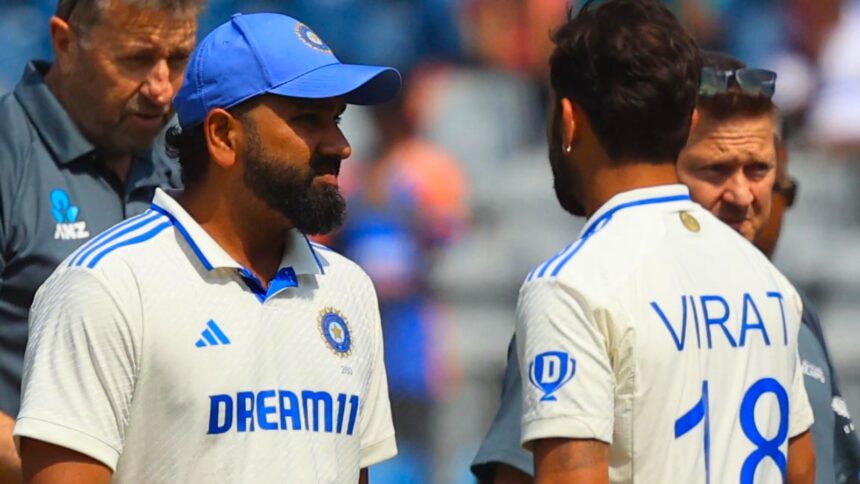Somehow, Australia has had this effect on Indian batting careers. Rahul Dravid and VVS Laxman lost their aura in the 2012 series down under, and both retired not long after. Sachin Tendulkar too didn’t have a good series, losing his aura a touch, and from then on it was a matter of time when he would call it a day. Now, it’s the turn of Rohit Sharma who couldn’t survive the nightmarish tour of Australia earlier this year, and has now retired from Tests after the selectors chose to move past him for Test captaincy.
But unlike those three, Rohit’s Test career never reached the heights it was expected to when a fresh-faced youngster lit up domestic cricket with his exquisite batting style that had even the hard-to-please, old-school cricketers purring in delight.
But things didn’t go his way. Neither the end – he averaged little over 6 in Australia and 15 in the home series against New Zealand – nor the start, where he struggled to cement his spot, was kind on him. For a brief while in the middle, especially when he opened the batting in England, he hit a few high notes, but it’s a Test career cluttered with more misses than hits. Perhaps it was that warmth of nostalgia of the highs in England (he averages 45 in Tests there as opener, easily his best outside India) that made him linger on in hope, but with the selectors forcing his hand, he has called it a day.
It might seem a mystery that Rohit the Test batsman never quite achieved a level of consistency. It’s not as if he wasn’t aware of the pitfalls of ‘talent’ and it’s not as if he got carried away by it. He did put in all the hard yards, genuinely objected to the portrayal of ‘lazy elegance’, and worked hard to change his game, but it didn’t quite go that way. Near the end of his career, Pakistan’s was rightly understood as a leg-spinner who could also bat. All the pressure exerted on the highly-combustible batsman to suppress his natural attacking urges didn’t work as he was, in essence, a spinner who could hit big.
saw himself in a somewhat similar light. In one of the chats, over the years, he had said as much. How he had started his career as a bowler. “I was never a batsman. All this natural talent, god’s gift that you guys talk about, isn’t right. I have worked a lot on my batting. I used to bat at No. 8 and made my way up. Ask my coach, Dinesh Lad, he will tell you that I was an off-spinner. One must get to the root of the matter. I became a serious batsman during my under-17 days. I broke the middle finger of my right hand during a 50-over match against the visiting Sri Lankans in 2005. It was difficult for me to grip the ball after that injury. That’s how I became a regular batsman. This ‘talent’ talk has messed things up for me.”
It hit like a bolt to hear him phrase his game in that way. It also helped one understand his relative slow progress in international cricket. It wasn’t akin to West Indies’s wondrous talent, Carl Hooper, who never quite made it as big as he should have in Test cricket. Hooper’s might have been a case of temperament, Rohit certainly didn’t see his game, in particular his Test career, in the same way. Others might, he doesn’t.
And he began to tinker and tweak his batting and mind. When he was asked by MS Dhoni to open the batting in white-ball cricket, he began to find out more about his game, by himself. He used to tap the bat on the ground at stance; he erased that, and started to hold his bat in the air.
“No one told me, it was my creation. I figured that out when I began to open the batting. I thought keeping the bat up gives me an opportunity to be in a good position to leave balls first. I was batting at number 5, one didn’t get the opportunity to leave the ball. So practicing constantly even in the nets to hit the ball. Even in Ranji Trophy I used to bat at 4-5, it was a bit different, you trained yourself up till then to be a middle order batsman. The first thing that came to my mind about opening was that the ball will swing and the guys will try to get you out behind the stumps. LBW is there, but mainly the ones who bowl good outswingers. What can I do? Keeping the bat up, allowed me to be in a good position to leave the ball. Earlier, when I used to keep my bat down I always used to feel that I had to play this ball. It was a flow,” Rohit had told this newspaper.
READ MORE: after Rohit Sharma steps down
Then when Ravi Shastri asked him to open in Tests in 2019 against South Africa, and later in England too, more changes had to be made. Again by himself.
“It was in England I had to change my grip a little bit again to play very close to the body. It was a very technical thing. I never did it before; so it hurt my wrists. In England I batted a lot, like almost 500-600 balls I faced in the England series. I thought Jimmy Anderson was going to bowl, what has he done all his life in the UK? What does he look to do? I thought about it. We had 15 days to prepare. I adjusted my grip to make the bat come down as close to the body as possible.”
In that brief phase of a golden run, Rohit the Test opener was a classicist, and a minimalistic marvel. Almost Jacques Kallis-ish compact serenity in the waiting in stance. The balls kept swinging away, and the bat would come down straight, not pushing, not itching, not fatally attracted to the ball. The batsman who had started at No. 8 had done the remarkable transformation. Or so one thought, but the blinds came down.
READ MORE | EXPRESS EXCLUSIVE:
Essentially what worked in England, remained the same but holes were opened up elsewhere. When the ball seams just a bit, as it did in Australia, his bat would still come down straight on that off-stump line, but it wasn’t enough. If the ball straightened, it would take the outside edge (not move away as exaggeratedly as it did in England to miss the edge). If it seamed back in, it would move past the inner edge and trap him lbw. He didn’t have that last-instant adjustment of the wrists that some great Test batsmen possess, with the bat coming in at an angle to stub out the danger. Case in point, and such, all have that last-fraction-of-a-second adjustment. Rohit didn’t. And his Test game slowly began to wither. Add to it, the slowing down of his reaction time has also affected. Once he pressed the front leg, the push-back to react to the demands of a short ball wasn’t as quick. Resultantly, the weight transfer and balance took a hit. Unsurprisingly, so did his Test game.
Taking him as a captain and as opening batsman for a series in England, even if their bowling attack, barring Jofra Archer, isn’t as strong as it was a year ago, was a risky affair. And the selectors weren’t in the mood for that risky equity market.
READ MORE: after Rohit Sharma steps down
“It’s all written in the destiny – you will get this amount. Whatever I do, I am going to get only this. I don’t want to be hyper self critical with Test cricket; I am happy with what I have done,” Rohit recently said on journalist Vimal Kumar’s YouTube channel. “What the world thinks, expects doesn’t matter as they are not part of my journey. No one knows how I have dealt with training, handled ups and downs in my life, no one apart from your close ones.I don’t keep unreal expectations, it’s simple.”
Seen in that prism, and how he saw himself as a No. 8 batsman who moved up the order and in career, his Test career makes sense. Considering his batting with its inherent frailties, he was perhaps not going to hit Test highs for too long. But it’s still hard to escape a sigh about the what-ifs. Maybe he didn’t quite see it himself, but could he have seen and accepted what others saw in him, and convinced himself that he was of that calibre and extended himself? Sometimes, as recently said, it’s others who open up that portal in oneself. Like Mark Boucher did with Kohli, telling him if he made a few changes, he could be an India international star. A Jambavan to Hanuman, sort of. But life doesn’t always work like that and for a self-made man, Rohit’s Test career in the bigger picture meets his self-expectations. And that’s where we have to leave it.








